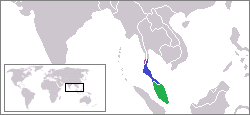|
Sri Thammasokaraj
Sri Thammasokaraj ( Thai language: Á¡Á¡ÈÁ¡¯Á¿Á¡Á¿Á¡ýÁ¡´Á¡ÈÁ¡çÁ¡Á¡ÈÁ¡ÈÁ¡ÀÁ¿Á¡´Á¡Á¡ÈÁ¡ýÁ¡ or sometimes called Á¡Á¡ÈÁ¡¯Á¿Á¡Á¿Á¡ýÁ¡´Á¡ÈÁ¡çÁ¡Á¡ÈÁ¡ÈÁ¡ÀÁ¿Á¡´Á¡Á¡ýÁ¡ÈÁ¡ýÁ¡; ?-1230) is the founder and first king of Nakhon Si Thammarat Kingdom or Ligor City which succeeded the Tambralinga Tambralinga ( sa, Támbraliÿ ga) was an Indianised kingdom located on the Malay Peninsula, existing at least from the 10th to 13th century. It was under the influence of Srivijaya for some time, but later became independent from it. The name ha ... kingdom. {{DEFAULTSORT:Thammasokaraj, Sri History of Nakhon Si Thammarat Year of death missing 1230 deaths Founding monarchs ... [...More Info...] [...Related Items...] OR: [Wikipedia] [Google] [Baidu] |
Nakhon Si Thammarat Kingdom
Nakhon Si Thammarat Kingdom ( th, Á¡ÙÁ¡ýÁ¡Á¡ýÁ¡Á¡ÝÁ¡Á¡ÈÁ¡Á¡Á¡ÈÁ¡´Á¡ÈÁ¡çÁ¡Á¡ÈÁ¡ÈÁ¡ÀÁ¡ÈÁ¡ýÁ¡ ), Nagara Sri Dharmarashtra or Kingdom of Ligor, was one of the major constituent city states (''mueang'') of the Siamese kingdoms of Sukhothai and later Ayutthaya and controlled a sizeable part of the Malay peninsula. Its capital was the eponymous city of Nakhon Si Thammarat in what is now Southern Thailand. Establishment and Sukhothai period Most historians identify the Tambralinga kingdom (existing c. 10th to 13th century) with a precursor of Nakhon Si Thammarat. During the late-1st and early-2nd millennium CE, Tai peoples expanded in mainland Southeast Asia. By the 13th century, they made Nakhon Si Thammarat one of their ''mueang'' (city states). The exact circumstances of the Tai taking over the earlier Buddhist and Indianised kingdom at this location remain unclear. The Ramkhamhaeng stele of 1283 (or 1292) lists Nakhon Si Thammarat as the southernmost tributary kingdom ... [...More Info...] [...Related Items...] OR: [Wikipedia] [Google] [Baidu] |
Tambralinga
Tambralinga ( sa, Támbraliÿ ga) was an Indianised kingdom located on the Malay Peninsula, existing at least from the 10th to 13th century. It was under the influence of Srivijaya for some time, but later became independent from it. The name had been forgotten until scholars recognized Tambralinga as Nakhon Si Thammarat (Nagara Sri Dharmaraja). In Sanskrit and Prakrit, ''tám(b)ra'' means "copper", "copper-coloured" or "red" and ''linga'' means "symbol" or "creation", typically representing the divine energy of Shiva. Tambralinga first sent an embassy to China under the Song dynasty in 1001. In the twelfth century it may or may not have been under the suzerainty of the Burmese Pagan Kingdom and Sri Lanka. At its height in the mid-13th century, under King Chandrabhanu, Tambralinga was independent, regrouping and consolidating its power and even invading Sri Lanka. By the end of the 13th century, Tambralinga was recorded in Siamese history as Nakhon Si Thammarat, under the su ... [...More Info...] [...Related Items...] OR: [Wikipedia] [Google] [Baidu] |
History Of Nakhon Si Thammarat
Nakhon Si Thammarat Municipality ( th, Á¿Á¡Á¡´Á¡Á¡ýÁ¡ËÁ¡Á¡Á¡ÈÁ¡Á¡Á¡ÈÁ¡´Á¡ÈÁ¡çÁ¡Á¡ÈÁ¡ÈÁ¡ÀÁ¡ÈÁ¡ýÁ¡, ; from Pali ''Nagara Sri Dhammaraja'') is a municipality (''thesaban nakhon'') in Southern Thailand, capital of Nakhon Si Thammarat province and Mueang Nakhon Si Thammarat district. It is about south of Bangkok, on the east coast of the Malay Peninsula. The city was the administrative center of southern Thailand during most of its history. Originally a coastal city, silting moved the coastline away from the city. The city has a much larger north to south extension than west to east, which dates back to its original location on a flood-save dune. The modern city centre on the train station is north of Old Town. As of 2019, the city had a population of 102,152. Toponymy Thai honorific ''Sri'' or ''Si'' is from Sanskrit Sri; , from Dharma; , from Raja. ''Dhammaraja'' means "righteous ruler", an important Theravada concept. History Nakhon Si Thammarat is one of the oldes ... [...More Info...] [...Related Items...] OR: [Wikipedia] [Google] [Baidu] |
Year Of Death Missing
A year or annus is the orbital period of a planetary body, for example, the Earth, moving in its orbit around the Sun. Due to the Earth's axial tilt, the course of a year sees the passing of the seasons, marked by change in weather, the hours of daylight, and, consequently, vegetation and soil fertility. In temperate and subpolar regions around the planet, four seasons are generally recognized: spring, summer, autumn and winter. In tropical and subtropical regions, several geographical sectors do not present defined seasons; but in the seasonal tropics, the annual wet and dry seasons are recognized and tracked. A calendar year is an approximation of the number of days of the Earth's orbital period, as counted in a given calendar. The Gregorian calendar, or modern calendar, presents its calendar year to be either a common year of 365 days or a leap year of 366 days, as do the Julian calendars. For the Gregorian calendar, the average length of the calendar yea ... [...More Info...] [...Related Items...] OR: [Wikipedia] [Google] [Baidu] |
1230 Deaths
1 (one, unit, unity) is a number representing a single or the only entity. 1 is also a numerical digit and represents a single unit of counting or measurement. For example, a line segment of ''unit length'' is a line segment of length 1. In conventions of sign where zero is considered neither positive nor negative, 1 is the first and smallest positive integer. It is also sometimes considered the first of the infinite sequence of natural numbers, followed by 2, although by other definitions 1 is the second natural number, following 0. The fundamental mathematical property of 1 is to be a multiplicative identity, meaning that any number multiplied by 1 equals the same number. Most if not all properties of 1 can be deduced from this. In advanced mathematics, a multiplicative identity is often denoted 1, even if it is not a number. 1 is by convention not considered a prime number; this was not universally accepted until the mid-20th century. Additionally, 1 is the ... [...More Info...] [...Related Items...] OR: [Wikipedia] [Google] [Baidu] |



